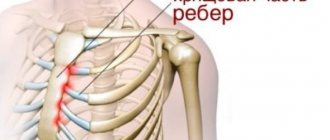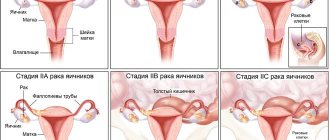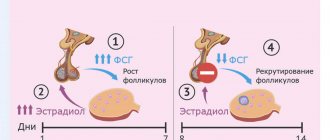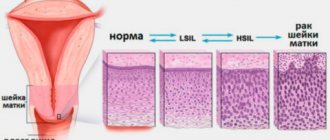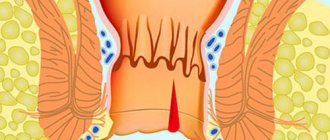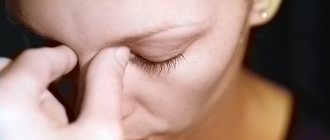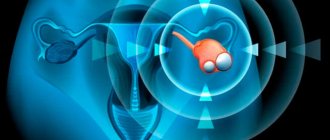Traumatologist-orthopedist
Shelepov
Alexander Sergeevich
12 years of experience
Doctor
Make an appointment
A less common genetic pathology characterized by changes in connective tissue is Marfan syndrome. People with classic signs of this disease are easy to recognize by their characteristic appearance. Almost all of them are characterized by abnormally high growth and asthenic physique, elongated limbs and fingers, and excessively mobile joints. The disease is characterized by various pathological changes in the structure of the skeleton, heart muscle and blood vessels, and organs of vision. The incidence of Marfan syndrome is low and amounts to one per 10-20 thousand newborns, and this indicator is not influenced by gender or race.
Marfan syndrome - what is it? Inheritance type
This disease is autosomal dominant. It is based on mutations in the FBN1 gene, which is responsible for the synthesis of fibrillin, one of the most important proteins for normal life, which maintains the elasticity of connective tissue. With Marfan's disease, its deficiency occurs, and this leads to the fact that the connective tissue loses strength and elasticity, and the person cannot withstand large physiological loads. The aorta and zonular ligament of the eye, which contains large amounts of fibrillin, are also affected. There are many elastic fibers throughout the human body, but their greatest concentration is in these structures. Often the death of a patient occurs precisely from an aortic aneurysm.
Medical research confirms that in 75% of cases, Marfan syndrome is transmitted through families, and only in the remaining 25% of cases is it caused by a primary sporadic mutation.
It was also found that the likelihood of having a baby with Marfan syndrome increases depending on the age of the father: the older he is, the greater the risk.
Pathological anatomy
On morphological examination, the elastic fibers are thinned, unevenly located, and in some places chaotically; There is a dissection of the middle tunic of large vessels, loosening of the endothelial layer, and the formation of cushion-like projections into the lumen of the vessel in the endothelial and subendothelial layers (see Dissecting aneurysm). The elastic framework of the aorta and pulmonary trunk is poorly developed. Myocardium with dystrophic changes, vacuolization, and in places with sharp swelling of fibers. In the bone tissue, there is sparseness of the bone beams and uneven deposition of lime; the structure of cartilaginous tissue is disrupted due to the formation of collagen bundles that stratify the interstitial substance.
Manifestations of the disease
This pathology is accompanied by many disorders in the body. The so-called “Marfan triad” is damage to skeletal bones, diseases of the cardiovascular system and various visual impairments. However, it should be noted that this syndrome does not affect mental abilities in any way.
Patients are usually distinguished by a disproportionate build: with a fairly high stature, they have a short torso, long arms and fingers resembling spiders (arachnodactyly), an asthenic physique with muscle hypotonia, chest deformation, severe curvature of the spine (kyphosis, scoliosis, subluxations and dislocations cervical spine), flat feet.
Marfan syndrome, accompanied by an anomaly of the cardiovascular system, is expressed in defects in the walls of large vessels, especially the aorta and large branches of the pulmonary vessels, and cardiac malformations. These changes often form in the developing fetus. The most dangerous form of Marfan syndrome, the symptoms of which appear at birth, leads to progressive heart failure and death in the first year of the baby's life.
Diagnostics
Diagnosis is based on a thorough collection of anamnesis of the disease, the severity of the clinical picture, examination data, and the results of laboratory and instrumental research methods.
Anamnesis collection includes: the presence of this pathology in the family (parents, brothers, sisters) or the presence of factors that provoke a mutation in the human genome.
Laboratory methods include: DNA genotype analysis with a mutating gene, determination of glycosaminoglycans in urine.
Instrumental research methods include:
- ECG is used to detect vascular and cardiac pathology (CVC). Characteristic disturbances of rhythm and conduction are identified in the form of atrial fibrillation, ventricular extrasystole, and the development of dilated hypertrophy of the left ventricular myocardium.
- EchoCG also serves to detect CVS pathology. Dilation of the aorta and its structures, prolapse of the bicuspid valve, and an increase in the size of the left half of the heart are detected.
- An ultrasound of the heart is performed to determine complications (dissecting aneurysm).
- X-ray of the chest organs (skeletal changes, expansion of the cavities of the heart, roots of the lungs, etc.)
- Computed tomography, magnetic resonance imaging allows us to identify pathologies of the osteoarticular, nervous system, and circulatory disorders in the vessels of the brain and spinal cord.
These research methods are used to detect criteria for Marfan syndrome in various organs and systems. They play the most important role in making and confirming the diagnosis, and subsequently, in determining treatment tactics.
The following criteria for diagnosing Marfan syndrome exist:
| System | Large criteria | Small criteria |
| Musculoskeletal system There must be: 4 major criteria, or 2 major and 1 minor. |
|
|
| Organ of vision | Lens displacement | Flattened cornea, myopia, farsightedness, underdevelopment of the iris and ciliary muscle of the eyes. |
| The cardiovascular system | Expansion of the aorta and its structures | Prolapse of the bicuspid valve, dilatation of the pulmonary valve in persons under 40 years of age, deposition of calcium salts on the leaflets of the bicuspid valve, dissection of the aorta. |
| Respiratory system | None | Sudden development of pneumothorax (accumulation of air in the chest), apical bullae. |
| Leather | None | Re-development of hernial protrusions, atrophic striae. |
| Nervous system | Dilation of the vessels of the spinal cord membranes in the lumbar/sacral part of the spinal column. | None |
| Genetic changes | The presence of these criteria in parents, children, brothers, sisters, grandparents. The presence of a mutating gene encoding fibrillin 1. | None |
To make a diagnosis of “Marfan syndrome”, one sign from the list of major criteria or a minor criterion characteristic of each of the affected systems, except for the musculoskeletal system, is taken into account (at least 4 criteria are required), as well as the presence in the family history of patients with this pathology .
Marfan syndrome in children and adults, accompanied by an anomaly in the development of the visual apparatus
Various lesions of the visual organs in this disease are diagnosed in 50-80% of patients, and disorders begin to appear in childhood. These may be the following pathologies:
- ectopia lens;
- severe myopia;
- flattening and increasing the size of the cornea;
- strabismus;
- hypoplasia of the iris and ciliary muscle;
- changes in the retina;
- destruction of the vitreous body and others.
Treatment of eye diseases is carried out using the usual methods in such cases. However, their effects may be complicated by ongoing processes in the body. Let's take a closer look at the ophthalmological pathologies associated with Marfan syndrome.
Myopia
This visual impairment occurs in more than half of patients. Its causes may be: the spherical shape of the lens, a change in the refractive power of the cornea of the eye due to its flattening and enlargement, as well as rapid growth along the anteroposterior axis of the eyeball itself. In this case, myopia can reach quite high degrees.
In childhood, pathology is treated with glasses. From 8-10 years of age, contact lenses can also be used.
Sick children can also often develop lazy eye syndrome - amblyopia. Parents of young patients with Marfan syndrome should be very attentive to the child’s vision condition. Amblyopia often turns into strabismus or vice versa.
Can weak connective tissue be dangerous?
Due to impaired valve function, there is an increased risk of developing cardiovascular pathology. During pregnancy, women with such changes increase the likelihood of aortic dissection due to hypersecretion of estrogens, which slow down the flow of collagen and elastin into the aorta.
Weakness of the ligamentous apparatus of the eye in adults is manifested by glaucoma or the formation of retinal degeneration with subsequent detachment. During the period of active rapid growth, the development of severe scoliosis and protrusion of the acetabulum is observed. Radiologically, these signs are clearly visible in the photographs.
It is recommended that persons with external signs of Marfan syndrome be subjected to mandatory examination by an ophthalmologist and cardiologist, as well as genetic testing to identify the altered gene.
ONLINE REGISTRATION at the DIANA clinic
You can make an appointment by calling the toll-free phone number 8-800-707-15-60 or filling out the contact form. In this case, we will contact you ourselves.
If you find an error, please select a piece of text and press Ctrl+Enter
Ectopic lens
Ectopic lens of the eye is its displacement from its normal position. Due to the stretching and weakness of the ligaments of cinnamon, on which it rests, they rupture. If the damage is partial, then the lens is displaced, but is still supported by the remaining ligaments - this is called subluxation. If the ligaments of Zinn are completely torn off, then it descends into the cavity of the eye, freely changing its position - this condition is called dislocation.
In Marfan syndrome, the ligaments of Zinn are weak or underdeveloped, so complete or partial ectopia of the lens is not uncommon.
The main symptom of this visual disorder is iris trembling - iridodonesis. The depth of the anterior chamber of the eye in the direction of lens displacement becomes shallower. A doctor can detect iridodonesis through instrumental examination. The patient, for his part, experiences diplopia - double vision and deterioration in clarity of vision. If the dislocation occurs in the anterior chamber of the visual organ, then it can be seen from the outside - it looks like a golden drop of oil. In this case, pain and hyperemia may be observed in the eye area.
Partial uncomplicated lens subluxation does not require special therapy. Suitable contact lenses are prescribed to maintain quality of vision. Sometimes, to eliminate it, a minimally invasive transscleral IOL fixation method is used. A special device is implanted into the damaged eye, which performs the function of the zonules of zinn - it firmly holds the lens in its anatomical place.
Cataracts and glaucoma in Marfan syndrome
Complications with ectopia of the lens can manifest itself in its clouding - then cataracts develop. At the same time, the quality of vision gradually decreases, and the process is irreversible. The disease must be treated in a timely manner. Typically, surgery is prescribed when approximately 50% of the lens is clouded. Modern methods in ophthalmology make it possible to easily cope with this visual impairment. To do this, a surgical operation is performed: the lens is removed through phacoemulsification, and an intraocular lens is implanted in its place. It replaces the natural one and provides high quality vision for a long time.
With Marfan syndrome, secondary glaucoma can also develop - a condition in which the flow of intraocular fluid from the posterior chamber of the eye to the anterior chamber is blocked, and therefore intraocular pressure sharply increases.
In this situation, glaucoma is treated in the same ways as usual. Medications are prescribed to lower blood pressure and increase the outflow of intraocular fluid. In more severe cases, surgery may be prescribed to improve the drainage of fluid.
Forecast
The average life expectancy for Marfan syndrome is 30-45 years.
It is known that many famous personalities suffered from this syndrome. This is Hans Christian Andersen, a Danish writer, author of the famous Little Mermaid; Abraham Lincoln - 16th President of the United States, Michael Phelps - famous swimmer, multiple Olympic champion. As well as famous composers - Niccolo Paganini, Sergei Rachmaninov.
People with this pathology should carefully monitor their health, constantly monitor and consult with their doctor, and avoid excessive physical activity.
In addition to drug treatment, it is necessary to carry out preventive measures in order to improve general well-being, increase immunity, and an appropriate work and rest schedule.
Iris diseases
Marfan syndrome is often accompanied by changes in the iris - this is due to increased tissue extensibility. Colobomas, hypoplasia or atrophy of the iris may occur with disruption of its diaphragmatic function. Coloboma is a defect manifested in the absence of part of the eye membrane. It is usually pear-shaped and located in the lower part of the iris. The earliest manifestations in people with Marfan syndrome include hypoplasia of the iris stroma, especially its pigmented pupillary border. The weakness of the dilator (dilator muscle) in patients does not allow achieving complete dilation of the pupil even with the help of mydriatics.
Classification
Forms of pathology:
- erased – patients have minor changes in 1 or 2 body systems;
- pronounced - the presence of mild disorders in 3 systems or characteristic pathological disorders in at least 1 system.
The nature of the syndrome:
- progressive – over time the pathology increases and worsens,
- stable – signs of the disease remain unchanged over many years of observation.
Etiological classification:
- familial form - inherited according to an autosomal dominant principle;
- sporadic form - the syndrome is caused by a random mutation of genes during conception.
Retinal pathologies in Marfan syndrome
Due to the weakness of the connective tissue, the retina of the eye is also subject to stretching. As a result, the risk of peripheral chorioretinal dystrophy increases - local thinning of the retina, which can provoke rejection of the layer of light-sensitive cells from the pigment epithelium. This disorder is very dangerous: visual acuity begins to fall, the perception of light and color deteriorates.
Signs of retinal detachment may include the following:
- flashes, sparks in the eyes - this phenomenon is called photopsia;
- distortion of the shape, size and shade of objects - metamorphopsia;
- “spots” and black dots before the eyes as a result of damage to the retinal vessel;
- loss of individual elements in the visible image from the field of view is a sign that the detachment began in the central zone of the retina;
- the appearance of a dark veil covering an increasingly larger area, decreased peripheral visibility.
Retinal detachment can now be successfully treated using a variety of methods. The most effective of them is laser coagulation - cauterization of damaged areas in order to reliably connect them to the choroid.
How is Marfan syndrome diagnosed?
There are no special tests that would allow us to establish the presence of this pathology. To confirm it, you need to undergo examination by several specialists. Moreover, symptoms of the disease may not appear immediately after birth, but throughout the child’s life - sometimes this happens at 10 and 16 years of age.
An orthopedist will identify disorders associated with bone structures: curvature of the spine and deformation of the chest, as well as flat feet, elongation of the tubular bones of the skeleton, hypermobility of the joints.
A geneticist will take a family history to identify relatives who died from heart disease.
An ophthalmologist will conduct an examination using a slit lamp, as well as using other modern methods of examining the organs of vision, to identify existing eye pathologies.
The cardiologist will prescribe a chest x-ray, electrocardiogram, echocardiogram and other methods. Usually, after collecting information from all specialists, a small consultation is appointed, where doctors make a final diagnosis. In this case, it is important to make an accurate decision. Not all people with long and thin fingers or spinal curvature have Marfan syndrome. On the other hand, similar symptoms may be accompanied by other diseases associated with connective tissue weakness.
Control and treatment of the disease
Children with Marfan syndrome should be constantly under medical and home supervision. Their body grows and develops quite quickly, especially during adolescence, and then they will need examinations by an ophthalmologist, orthopedist and other specialists, and therapeutic measures, if necessary. If you follow the recommendations for patients with Marfan syndrome, you can maintain your health for a long time.
It is very important not to put too much stress on the heart, given the possibility of rupture of the aorta or major vessels at any time. Sports that involve running, severe muscle tension, or the risk of getting hit in the chest are contraindicated for both children and adults: basketball, volleyball, boxing, weightlifting and similar sports disciplines.
This does not mean that activity is completely contraindicated for them. Such people can and should maintain physical fitness. For example, cycling, slow dancing, walking, swimming are quite suitable in this situation.
Many manifestations of Marfan syndrome are controlled with medications and, if necessary, surgery. Thus, beta-blockers are used to lower blood pressure and reduce wear and tear on the walls of blood vessels, which slows down the progression of aortic aneurysm. If it becomes too large or the heart valve is causing concern, surgery may be indicated.
Children suffering from myopia or lazy eye syndrome are prescribed corrective glasses or contact lenses.
If scoliosis develops, you may have to wear a special support corset and engage in exercise therapy. In particularly severe situations, severe deformation of the chest or spine may require surgery. In some countries, children and adolescents with Marfan syndrome wear an information bracelet. This will be needed in a critical case so that doctors know the patient’s diagnosis.
Prognosis and prevention
The course of the disease largely depends on the severity of clinical manifestations and the quality of treatment provided. Malformations of the heart and blood vessels and their pathological changes pose a particular danger to the life of a child, so the treatment of this group of diseases is given a special place.
Parents of girls need to be aware of the dangers of future pregnancy for the health of a patient with hereditary syndrome. It is during pregnancy that the risk of developing and dissecting an aortic aneurysm increases. This is due to increased stress on the circulatory system and hormonal changes.
In general, with proper treatment and timely assistance, patients with a genetic syndrome live to a ripe old age. The disease brings restrictions in choosing a future profession. It is better for such children to look for an activity that does not involve increased physical activity or heavy lifting.
Prevention of the disease consists of timely diagnosis of the syndrome in the family and medical and genetic counseling of future parents.
Tips for parents of a child with Marfan syndrome
Of course, it is sad and bitter to realize that a child has such a dangerous disease. However, only the correct behavior of parents will help overcome difficulties, including creating the necessary psychological attitude. You need to learn to live with this problem and constantly keep the child’s condition under control. It is important to find good specialists who will take care of his health.
He should also be taught to treat his condition with dignity and not react to possible ridicule from the outside. It is better to instill in him a love for activities that he can do in the future: let it be programming or, for example, music. If the diagnosis was made at an older age, you will have to give up some sports.
It is also important to establish good contact with teachers, explaining to them that this disease involves some special features. For example, it is better for him to sit at the first desk because of vision problems; he should not experience too much physical exertion. Every parent wants to provide their child with a happy childhood. Children with Marfan syndrome need to know that there are many interesting activities available to them in the world.
The disease does not respond to any specific treatment. Unfortunately, doctors have not yet learned how to change mutated genes. However, doctors will suggest a number of therapy variations aimed at improving the condition of a specific organ and preventing the development of complications.
